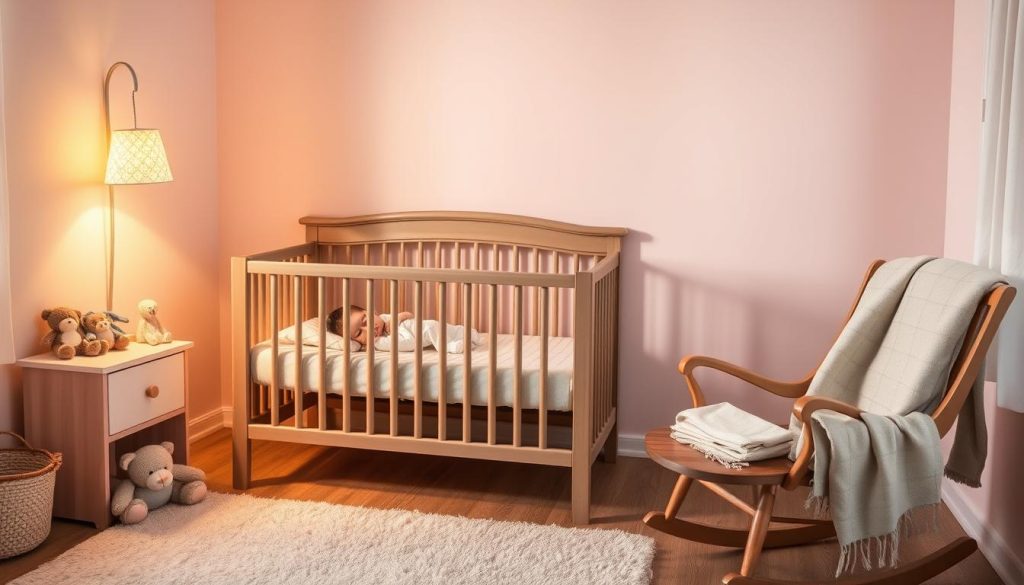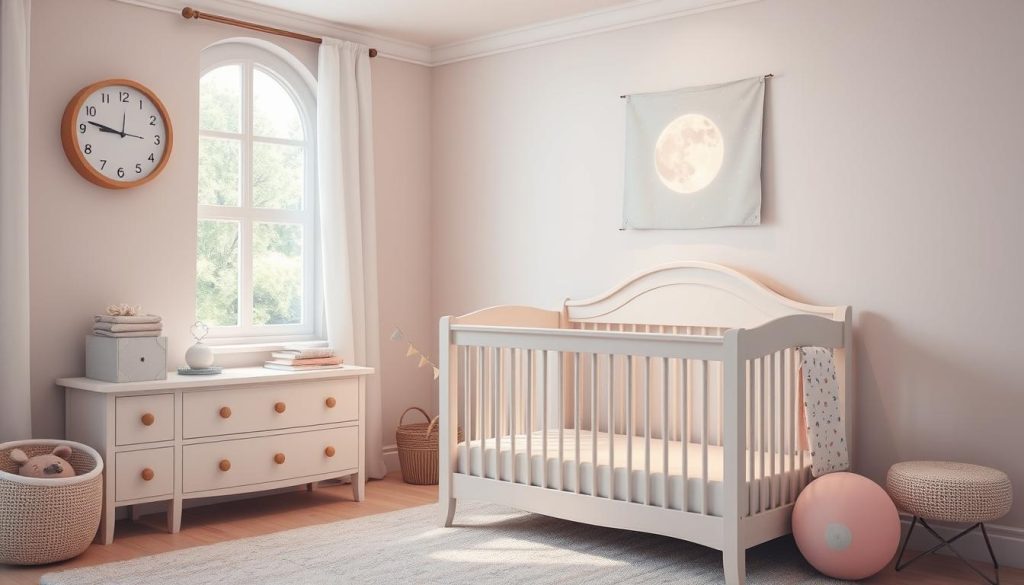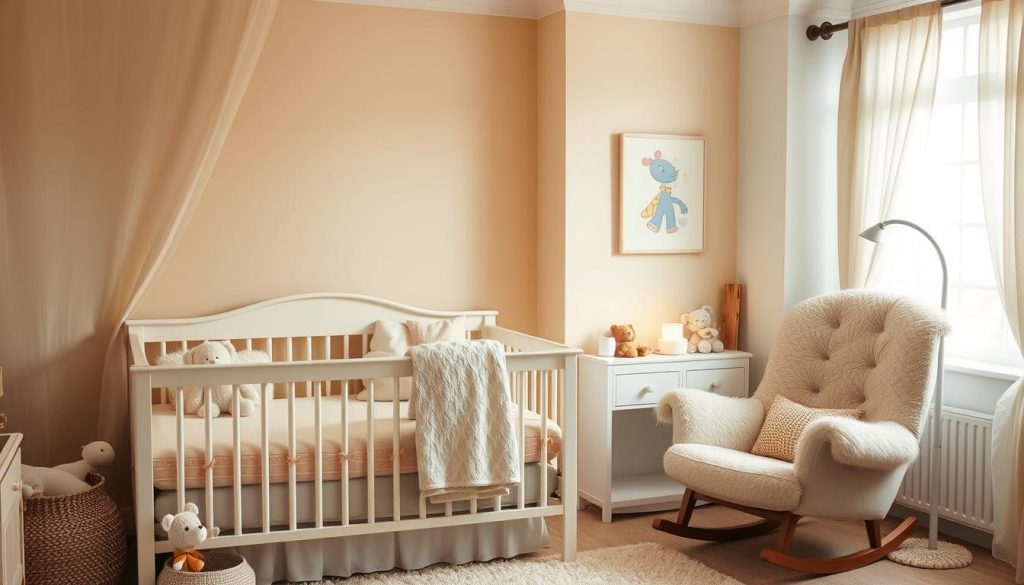
When I was a new mom, I felt overwhelmed trying to get my baby to sleep through the night. The sleepless nights and endless rocking were tough. But then, sleep training changed everything for us.
Sleep training is a big help for new parents. It teaches babies to sleep on their own and self-soothe. It’s not simple, but with the right tips, you can help your baby sleep better. This brings peace back to your home.
So, to help you, let’s talk about some baby sleep training tips you can use for your kids.
Key Takeaways
- Sleep training can help babies learn to sleep through the night, improving their sleep habits and teaching them to self-soothe.
- The recommended age to start sleep training is between 4-6 months old, when babies can typically sleep for six hours between feeds overnight.
- There are various sleep training methods to try, from the Ferber method to the cry-it-out approach, and it may take some experimentation to find the right fit for your family.
- Consistency and a calming bedtime routine are key to successful sleep training.
- Hiring a sleep consultant can provide valuable guidance and support for parents navigating the sleep training process.
Understanding the Foundations of Sleep Training
Successful sleep training means a baby can fall asleep on their own and sleep all night. This depends on their natural sleep cycles and body rhythms. It’s key for parents to know about baby sleep patterns and what’s normal at each age.
What Defines Sleep Training Success
The main goal is for babies to learn to fall asleep by themselves. This helps the whole family get better sleep. It usually takes 1-2 weeks to start seeing results, and sometimes a bit longer for naps and nighttime wakings.
The Science Behind Baby Sleep Patterns
Newborns sleep in a way that changes as they grow. By 3-4 months, they start to sleep more regularly. By 4 months, they can sleep for 6 hours without eating, and by 6 months, they often sleep all night with the right training.
Age-Appropriate Sleep Expectations
Babies need different amounts of sleep as they get older. Newborns sleep up to 17 hours a day, while 4-11 month-olds need 12-15 hours. By 12 months, they sleep 11-14 hours, including naps. Knowing these needs helps set realistic goals and choose the best sleep training method.

“Proper sleep is fundamentally important to a baby’s healthy development; studies show that well-rested babies have improved cognitive abilities, memory retention, and are happier and less moody than overtired babies.”
When to Start Sleep Training Your Baby
Being a parent is full of joy, but figuring out your baby’s sleep can be tough. Experts say to start sleep training between 4-6 months. This is because babies can sleep longer and soothe themselves better by then.
By 4 months, babies might sleep through the night without needing to eat. By 6 months, they usually have a regular sleep pattern. But remember, every baby is different. Some might be ready earlier, while others might take longer.
Before starting sleep training, make sure you and your partner are ready. Being consistent is key, and having your partner’s support is important.
Think about how often your baby wakes up at night, their age, and if your family is ready. By considering these things, you can make the transition to better sleep smoother.
“Sleep training is not a one-size-fits-all approach. It’s important to find the method that works best for your family and your baby’s unique needs.”

Choosing when to start sleep training is a personal decision. Pick a method that fits your parenting style and your baby’s personality. With patience and the right approach, your baby can develop good sleep habits for the whole family.
Essential Baby Sleep Training Tips for Better Rest
As a new parent, setting up a bedtime routine is key for your baby’s sleep. This can include a warm bath, reading, or singing a lullaby. It helps your baby know it’s time to sleep.
Also, making the sleep environment perfect is vital. The nursery should be dark, quiet, and just right for sleep. Use blackout curtains, white noise machines, and soft bedding to help.
When sleep training, handling night feedings is important. You can start by slowly cutting down on these feedings. This helps your baby learn to sleep longer without waking up.
- Establish a consistent bedtime routine to signal sleep time.
- Ensure the nursery environment is dark, quiet, and at a comfortable temperature.
- Manage night feedings gradually to encourage self-soothing and longer stretches of sleep.
“Consistency is key when it comes to establishing healthy sleep habits in babies. With a little patience and the right techniques, you can help your little one sleep better and wake up refreshed.”
Every baby is different, so finding the right sleep training method might take time. Be flexible, adapt, and trust your instincts as a parent.

The Truth About Common Sleep Training Myths
Many myths surround sleep training, like it always means “crying it out” or is bad for babies. But, research proves no harm from gentle sleep training methods. In fact, studies show it can cut sleep problems in parents by 30% in five months.
Not all babies do well with sleep training, Dr. Jodi Mindell says about 20% don’t. There’s no one-size-fits-all way to check on a baby during training. It must be adjusted for each child’s needs.
“Sleep training decreased resistance to sleep at bedtime and night wakings in 49 out of 52 studies reviewed.”
While it helps babies sleep better short-term, long-term effects vary. A study found babies might wake up one to two times a night three months later. But, Dr. Harriet Hiscock says it’s safe in the long run.
Research shows sleep training lowers infant cortisol levels. It also helps parents bond more due to better sleep. Parents may feel less depressed and anxious too.
No one sleeps through the night without waking, as sleep cycles involve checking surroundings. Babies need help learning to fall asleep and go back to sleep. Sleep training can help with this.
Contrary to what many think, sleep training doesn’t mean all naps must be in the crib. Gradually stopping night feedings is okay, based on the baby’s needs. Cry-it-out isn’t the only method; there are others like fading, pick-up/put-down, and the chair method.
In conclusion, sleep training might not work for every family. But, it can help babies and toddlers sleep better when done gently and with care. By clearing up myths and knowing the facts, parents can choose the best sleep training for their child.
Gentle Sleep Training Methods for Sensitive Babies
Parenting a sensitive baby is a delicate task, even when it comes to sleep training. Gentle sleep training methods aim to reduce crying and stress. They help your baby learn to sleep well without feeling upset. Let’s look at some effective and caring methods for sensitive sleepers.
The Fading Method Explained
The Fading Method is a gentle way to teach your baby to sleep on their own. You start by slowly reducing your role in their bedtime routine. This lets your baby learn to fall asleep by themselves. It’s great for families who sleep together because it’s flexible and doesn’t disturb others.
Pick-Up/Put-Down Technique
The Pick-Up/Put-Down Technique is another gentle method for sensitive babies. When your baby cries, you comfort them briefly, then put them back down. This way, you reassure them without breaking their sleep. It helps your baby learn to calm down by themselves.
The Chair Method Approach
The Chair Method lets you sit by your baby’s crib as they fall asleep. You move your chair further away each night. This keeps your baby feeling safe while teaching them to sleep alone. It’s very helpful for babies who get anxious when separated.
Every baby is different, so you might need to try a few methods to find the right one. With patience, consistency, and love, you can help your sensitive baby sleep well without stress.
“Gentle sleep training methods are a game-changer for sensitive babies. They provide the comfort and reassurance my little one needs while teaching important self-soothing skills.” – Emily, mom of two
Creating a Calming Bedtime Environment
Creating a calm bedtime space is key for baby sleep training. The right sleep environment helps your baby sleep well. A soothing and steady setting helps your baby sleep better.
Keep the nursery cool, between 68-72°F (19-21°C). Too hot can mess with sleep and raise SIDS risk. Dark rooms help your baby sleep by making melatonin, the sleep hormone.
- Aim for a darkness level of 8-10 on a scale of 1-10 to maximize sleep benefits.
- A fan can also reduce SIDS risk by up to 72%, making it a great sleep aid.
Minimize noise and create a calm sound environment. Use a white noise machine or soft sounds at 50-60 dB. This blocks out loud noises and tells your baby it’s time to sleep.
“Establishing a consistent, calming bedtime routine and sleep environment is one of the most important steps in successful sleep training. It helps your baby’s body and mind recognize the cues for sleep, making the transition to slumber smoother and more restful.”
Consistency is vital. The same sleep setup and bedtime routine help your baby’s internal clock. A peaceful bedtime space helps your baby sleep well.
Self-Soothing Techniques for Babies
Teaching your baby to calm themselves is key to sleep training. This skill lets them sleep alone and through the night. They might use their thumb or a comfort object to relax, not just you.
Teaching Independent Sleep Skills
Babies wake up a lot, but it’s normal. They cry at night, but some need help to fall back asleep. By letting them try to settle down alone, you help them sleep better.
Managing Sleep Associations
Babies often need help to sleep, like rocking or feeding. But, you can help them learn to sleep alone. This way, they won’t always need you to fall asleep.
Comfort Objects and Their Role
Comfort objects, like blankets or stuffed animals, give babies a sense of safety. They help babies learn to fall asleep by themselves. Using a comfort object during sleep training is a gentle way to help.
“Helping babies learn to self-soothe is a delicate balance. It’s important to provide a secure environment while also allowing them to explore and develop their own strategies for falling asleep.” – Ms. Ideran, Pediatric Occupational Therapist
Managing Night Wakings and Sleep Regressions
As your baby grows, you might face night wakings and sleep regressions. These are normal as your baby’s sleep patterns change. But, with the right strategies, you can help your baby through these changes more easily.
Night wakings are a normal part of a baby’s sleep. Responding the same way to these wakings helps your baby learn healthy sleep habits. During sleep regressions, your baby’s sleep might get disrupted. These usually last 1-2 weeks. Keeping up with your sleep training can help your baby get back to normal sleep.
- Stick to a consistent bedtime routine to cue your baby’s body that it’s time to wind down and sleep.
- Gradually extend the time before responding to night wakings, allowing your baby to self-soothe when possible.
- Maintain your baby’s daytime routine and nap schedule during regressions to provide stability.
- Offer comfort and reassurance, but avoid letting your baby fully wake during night wakings.
Remember, sleep regressions are temporary and often linked to developmental milestones. With patience and consistency, your baby will get through these phases and return to their healthy sleep patterns. By understanding the science behind sleep regressions and employing effective techniques, you can navigate these challenges with confidence and support your baby’s overall well-being.
“Consistency is key when it comes to managing night wakings and sleep regressions. Stick to your sleep training methods, and your baby will soon return to their normal sleep cycle.”
The Role of White Noise and Room Temperature
Creating a perfect sleep space for your baby involves white noise and the right room temperature. White noise is very effective in helping babies sleep better and longer. It helps them fall asleep and stay asleep.
Optimal Sleep Environment Settings
Studies show that up to 80% of newborns fall asleep in just 5 minutes with white noise. This is because it sounds like the womb, making them feel safe and relaxed. This promotes better sleep.
The American Academy of Pediatrics suggests keeping white noise at 50 decibels. This is like the sound of a soft shower. Also, keep the sound machine 6-7 feet away from the crib to avoid hearing damage.
Using Sound Machines Effectively
Keeping the room temperature right is also key for baby sleep. Experts say the nursery should be between 68-72°F (20-22°C). This ensures your baby sleeps well. Don’t use air conditioning too much, as it can disturb sleep.
Introduce sound machines as part of a bedtime routine. This helps your baby connect the sounds with sleep time. But, don’t rely too much on white noise. Gradually reduce the volume to help your baby sleep naturally.
“White noise can be an invaluable tool in supporting babies’ sleep, but it’s important to use it judiciously and with a plan to wean off its use over time.”
By making the sleep environment calm, consistent, and comfortable, you help your baby sleep well. Use the right temperature and white noise. Remember, every baby is different, so watch how they react and adjust as needed.
Establishing Consistent Nap Schedules
Consistent nap schedules are key for your baby’s sleep success. Offer naps at the same times each day in a dark room. Sound machines can help with soothing background noise for better naps.
The number and length of naps change with age. As your child grows, they need fewer naps but longer ones. An early bedtime can make up for short naps, ensuring they get enough sleep.
Age-Appropriate Nap Schedules
- Newborns (0-1 month) need 4-6 naps a day, lasting 15-120 minutes, for 5-6 hours of sleep.
- Infants (4-5 months) have 3-4 naps a day, lasting 30-120 minutes, for 3-4 hours of sleep.
- Toddlers (12-17 months) have 1-2 naps a day, lasting 60-180 minutes, for 2-3 hours of sleep.
Keep a 5-10 minute quiet, dark, and cool pre-nap routine. Encourage self-soothing to help your baby nap better. If they wake early, wait 5-10 minutes to let them settle back down.
“Consistency in setting up nap schedules and nap times is key for successful sleep training, leading to better sleep habits in babies.”
Understanding wake windows and nap lengths helps create a nap schedule that meets your baby’s needs. With consistent routines and patience, you can establish a healthy nap routine for both you and your baby.
Troubleshooting Common Sleep Training Challenges
Starting your baby’s sleep training can have its ups and downs. You might face issues like inconsistent sleep or trouble falling asleep alone. But, with the right strategies, you can get past these problems and help your baby sleep well.
One big challenge is when your baby wakes up a lot at night. Studies show that babies should sleep through most of the night within a week of starting sleep training. If your baby is waking up too often, it might be time to check their sleep space or bedtime routine.
- Make sure the sleep area is cozy, with the right temperature, little light, and quiet.
- Look at your bedtime routine again. It should be calming and the same every night, helping your baby learn to fall asleep.
- If what you’re doing now isn’t working, try a different sleep training method. But, give it at least a week to see if it helps.
Another problem is when your baby naps for just a short time. It can be tough for both of you. Experts say to wait 10 to 15 minutes after a short nap before taking your baby out of the crib. This helps them learn to fall asleep on their own and might make their naps longer.
If sleep training is really hard, it’s okay to ask for help. Talking to a pediatrician or sleep consultant can give you great advice and strategies. They can help your family get the sleep you all need.
“Maintaining consistency in the chosen sleep training method is vital for achieving positive results.”
Remember, sleep training is a journey. With patience, persistence, and some troubleshooting, you can help your baby sleep well. Keep going, and the effort will be worth it in the long run.
Supporting Parents During Sleep Training
Sleep training is tough for new parents. It’s full of emotions and stress. To succeed, parents need to manage their stress well. They can do this by setting realistic goals, taking care of themselves, and having a strong support network.
Managing Parental Stress
Crying is a normal part of sleep training. Babies get upset when they learn to sleep alone. Having a good plan and support from a sleep expert can help reduce crying.
It’s key for parents to take care of themselves too. They should share nighttime duties, rest well, and do things that relax them. Getting help from a partner, family, or joining a parent group can make parents feel less alone and give them valuable advice.
Building a Support System
Having a strong support system is very important. Working with a sleep consultant can give you personalized help and emotional support. This ensures parents are ready to face any challenges.
- Ask a partner, family, or friends to help with nighttime duties and offer emotional support.
- Join a local or online parent support group to meet others who are going through the same thing.
- Consider hiring a sleep consultant for specific advice and help with sleep training.
By focusing on self-care and building a strong support network, parents can handle sleep training better. Remember, this is just a short phase. With the right approach and support, your family will soon enjoy better sleep.
Alternative Approaches to Traditional Sleep Training
Some families choose gentler sleep training methods instead of the Ferber method or Cry It Out (CIO). The “no-cry” sleep training method helps adjust sleep habits without leaving the baby to cry. This method is less stressful for both the baby and parents.
Co-sleeping or bed-sharing is another alternative. Here, the baby sleeps in the parents’ bed. But, it’s important to follow safe sleep guidelines for the baby’s safety. Some parents let the baby learn to sleep independently over time, without strict sleep training.
These gentler methods might be better for families wanting a more caring sleep training experience. Even if it takes longer, focusing on the baby’s comfort and the parents’ feelings makes the journey more enjoyable for everyone.
Conclusion
In conclusion, the journey into parenthood often comes with its fair share of challenges, particularly when it comes to ensuring that our little ones get the sleep they need. For many, the methods and strategies surrounding baby sleep can feel overwhelming. However, enlisting the help of baby sleep consultants can provide invaluable support for parents seeking to create a nurturing sleep environment for their infants. These experts not only share insights into effective practices but also tailor their advice to fit the unique needs of each family.
One crucial aspect of sleep training is teaching babies to self-soothe, a skill that can significantly improve their ability to fall asleep independently. This process may initially seem daunting, but with guidance and persistence, it can lead to better sleep patterns for both babies and their parents. Self-soothing techniques typically involve allowing infants to explore their ability to calm themselves without immediate intervention, thereby gradually fostering their independence during sleep times.
Another valuable tool in the quest for better sleep is mastering swaddling techniques. Proper swaddling can mimic the comforting sensations of being in the womb, providing babies with a sense of security that promotes relaxation and sleep. When combined with methods aimed at teaching self-soothing, swaddling can be an effective strategy for helping babies transition into deeper sleep cycles.
Ultimately, establishing a consistent sleep routine that incorporates these strategies can make all the difference in a family’s dynamic. It’s essential to remember that while the process may take time and patience, the long-term benefits for both infants and parents are well worth the effort. As families navigate the complexities of sleep training, they can find comfort in knowing that support and resources are available to guide them toward restful nights and happier days.
Hope this baby sleep training tips will help you and your kids to have a wonderful sleep.




